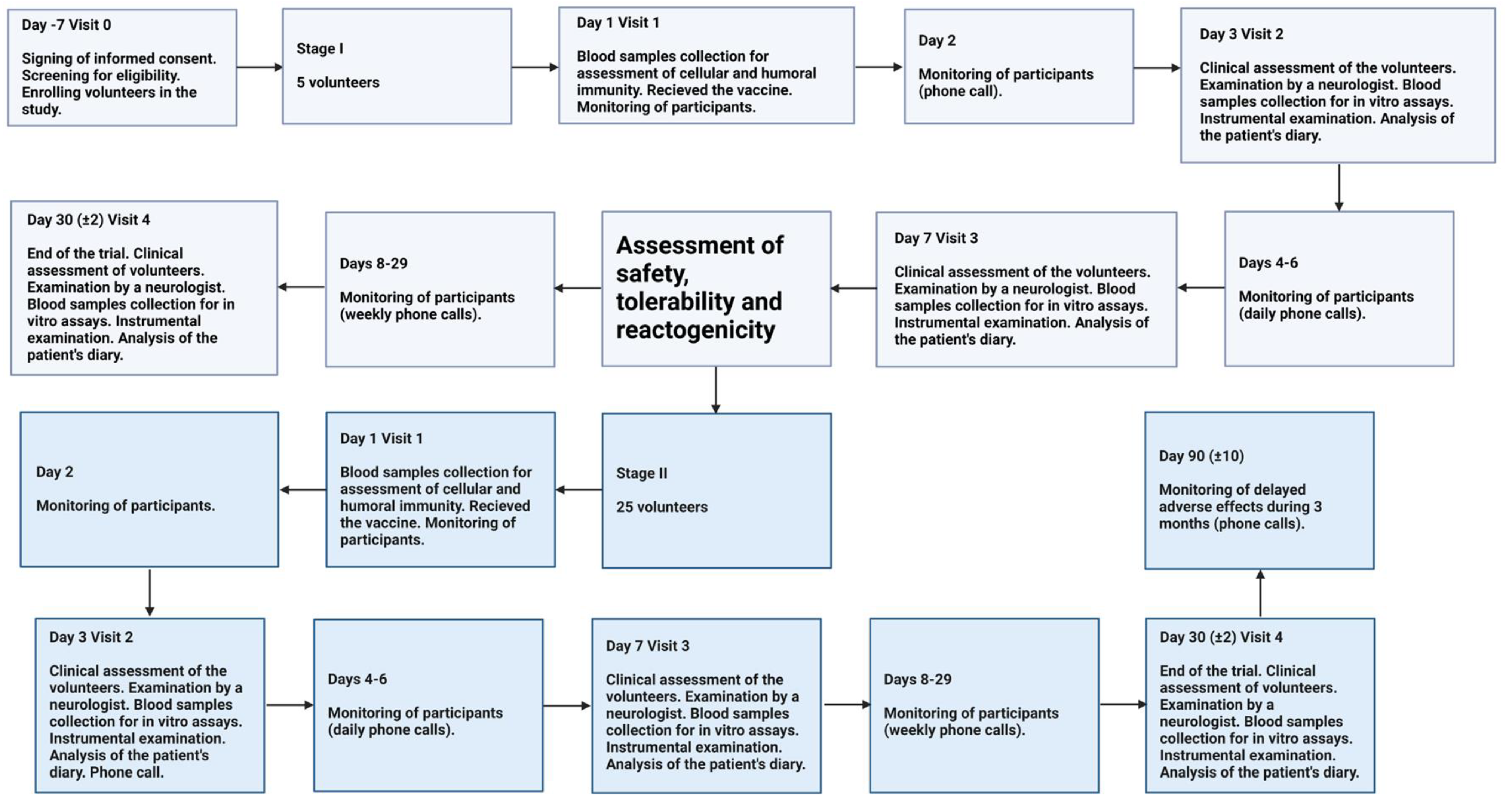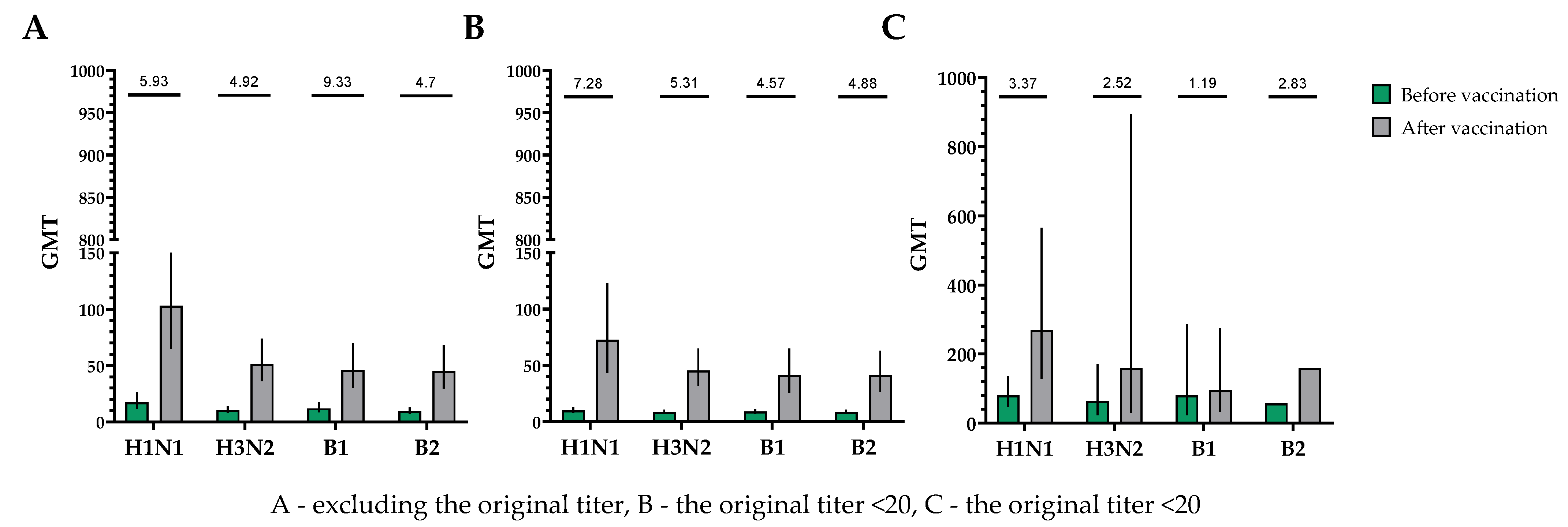Phase I Clinical Study of the Subunit Betulin-Adjuvanted Tetravalent Candidate Influenza Vaccine TetraFluBet
Abstract
1. Introduction
2. Materials and Methods
2.1. Study Objectives
2.2. Study Design Overview
2.3. Study Subjects
2.4. Formulations and Dosages of the Test Drug
2.5. Safety and Immunogenicity Outcomes
2.5.1. Study Endpoints
- Mild effects are described as having minor significance and being easily tolerated by the subject, causing minimal inconvenience and not interfering with daily activities.
- Moderate effects cause discomfort and interference with daily activities but are not life-threatening.
- Severe effects are those that may be life-threatening and interfere significantly with normal daily life.
2.5.2. Assessment Criteria for Safety, Tolerability and Reactogenicity
- The incidence rates and severity grades of local and systemic adverse reactions seven days after vaccination, according to subjective (patient’s diary) and objective (medical examination) data.
- Incidence rates and severity of AEs/SAEs.
- Proportion of participants who used antipyretics during the study, as well as the duration of their use.
- Frequency of clinically significant deviations from reference values in the laboratory, instrumental studies, vital signs and physical examination.
2.5.3. Assessment Criteria for Immunogenicity
2.6. Statistical Analysis
3. Results and Discussion
3.1. Vaccine Safety
3.2. Vaccine Immunogenicity
4. Conclusions
Supplementary Materials
Author Contributions
Funding
Institutional Review Board Statement
Informed Consent Statement
Data Availability Statement
Acknowledgments
Conflicts of Interest
References
- World Health Organization. Available online: https://web.archive.org/web/20170828235000/http://www.who.int/mediacentre/factsheets/fs211/en/ (accessed on 21 June 2024).
- Kostinov, M.P.; Erofeeva, M.K.; Harith, S.M. Efficacy and safety of influenza vaccination of different contingents. Terra Medica 2011, 2, 7–11. [Google Scholar]
- Popova, A.Y.; Ezhlova, E.B.; Melnikova, A.A.; Miheev, V.N.; Ryzhikov, A.B.; Ilicheva, T.N.; Domkina, A.M.; Mikheeva, I.V.; Saltykova, T.S.; Saltykova, T.S. The Impact Annual Immunization against Flu on Morbidity of Flu in the Russian Federation. Èpidemiol. Vakcinoprofil. 2016, 15, 48–55. [Google Scholar] [CrossRef]
- Federal State Budgetary Institution “Research Institute of Influenza” of the Ministry of Health of the Russian Federation. Available online: https://www.influenza.spb.ru/system/epidemic_situation/laboratory_diagnostics/?year=2018&week=03 (accessed on 22 August 2024).
- Fink, G.; Orlova-Fink, N.; Schindler, T.; Grisi, S.; Ferrer, A.P.S.; Daubenberger, C.; Brentani, A. Inactivated trivalent influenza vaccination is associated with lower mortality among patients with COVID-19 in Brazil. BMJ Evid. Based Med. 2020, 26, 192–193. [Google Scholar] [CrossRef] [PubMed]
- The Australian Immunisation Handbook. Available online: https://immunisationhandbook.health.gov.au/ (accessed on 21 June 2024).
- Belshe, R.B. The need for quadrivalent vaccine against seasonal influenza. Vaccine 2010, 28, 45–53. [Google Scholar] [CrossRef] [PubMed]
- Gorse, G.J.; Falsey, A.R.; Ozol-Godfrey, A.; Landolfi, V.; Tsang, P.H. Safety and immunogenicity of a quadrivalent intradermal influenza vaccine in adults. Vaccine 2015, 33, 1151–1159. [Google Scholar] [CrossRef] [PubMed]
- Demicheli, V.; Jefferson, T.; Ferroni, E.; Rivetti, A.; Di Pietrantonj, C. Vaccines for preventing influenza in healthy adults. Cochrane Database Syst. Rev. 2007, 18, CD001269. [Google Scholar]
- Dijkstra, F.; Donker, G.A.; Wilbrink, B.; Van Gageldonk-Lafeber, A.B.; Van Der Sande, M.A. Long time trends in influenza-like illness and associated determinants in The Netherlands. Epidemiol. Infect. 2009, 137, 473–479. [Google Scholar] [CrossRef] [PubMed]
- Cadorna-Carlos, J.B.; Nolan, T.; Borja-Tabora, C.F.; Santos, J.; Montalban, M.C.; de Looze, F.J.; Eizenberg, P.; Hall, S.; Dupuy, M.; Hutagalung, Y.; et al. Safety, immunogenicity, and lot-to-lot consistency of a quadrivalent inactivated influenza vaccine in children, adolescents, and adults: A randomized, controlled, phase III trial. Vaccine 2015, 33, 2485–2492. [Google Scholar] [CrossRef] [PubMed][Green Version]
- Choi, W.S.; Noh, J.Y.; Lee, J.; Choi, J.Y.; Lee, J.-S.; Kim, M.S.; Kim, H.S.; Bang, J.; Lavis, N.; Kim, W.J. Immunogenicity and safety of a split-virion quadrivalent influenza vaccine in adults 18–60 years of age in the Republic of Korea. Hum. Vaccines Immunother. 2018, 14, 587–592. [Google Scholar] [CrossRef] [PubMed]
- Kanra, G.; Marchisio, P.; Feiterna-Sperling, C.; Gaedicke, G.; Lazar, H.; Durrer, P.; Kürsteiner, O.; Herzog, C.; Kara, A.; Principi, N. Comparison of immunogenicity and tolerability of a virosome-adjuvanted and a split influenza vaccine in children. Pediatr. Infect. Dis. J. 2004, 20, 300–306. [Google Scholar] [CrossRef] [PubMed]
- Lu, C.-Y.; Ferracin, C.; Chiu, C.-H.; Lavis, N.; Huang, C.-H.; Huang, L.-M. Immunogenicity and safety of a quadrivalent influenza vaccine in children and adolescents in Taiwan: A phase III open-label trial. Trials Vaccinol. 2016, 5, 48–52. [Google Scholar] [CrossRef][Green Version]
- Pepin, S.; Szymanski, H.; Kobashi, I.A.R.; Martinez, S.V.; Zamora, J.F.G.; Brzostek, J.; Huang, L.-M.; Chiu, C.-H.; Chen, P.-Y.; Ahonen, A.; et al. Safety and immunogenicity of an intramuscular quadrivalent influenza vaccine in children 3 to 8 y of age: A phase III randomized controlled study. Hum. Vaccines Immunother. 2016, 12, 3072–3078. [Google Scholar] [CrossRef] [PubMed]
- Domachowske, J.B.; Pankow-Culot, H.; Bautista, M.; Feng, Y.; Claeys, C.; Peeters, M.; Innis, B.L.; Jain, V. A randomized trial of candidate inactivated quadrivalent influenza vaccine versus trivalent influenza vaccines in children aged 3–17 years. J. Infect. Dis. 2013, 207, 1878–1887. [Google Scholar] [CrossRef] [PubMed]
- Langley, J.M.; Martinez, A.C.; Chatterjee, A.; Halperin, S.A.; McNeil, S.; Reisinger, K.S.; Aggarwal, N.; Huang, L.-M.; Peng, C.-T.; Garcia-Sicilia, J.; et al. Immunogenicity and safety of an inactivated quadrivalent influenza vaccine candidate: A phase III randomized controlled trial in children. J. Infect. Dis. 2013, 208, 544–553. [Google Scholar] [CrossRef] [PubMed]
- Tcymbarevich, I.; Krasheninnikova, A.; Sukhova, M.; Ivanov, A.; Stukova, M.; Romanovskaya-Romanko, E.; Mikhailova, N.; Belkin, A.; Belyakova, O.; Nicolaeva, A.; et al. TetraFluBet: A Tetravalent Influenza Vaccine Enhanced with Natural Betulin Adjuvant. Infect. Dis. Prev. Med. 2024, 12, 1000371. [Google Scholar]
- Isaev, A.A.; Krasilnikov, I.V.; Frolova, M.E.; Kudryavtsev, A.V.; Vakhrusheva, A.V.; Ivanov, A.V. Method for preparation of betulin for use as adjuvant in vaccine against SARS-CoV-2 coronavirus. RU 2749193 C1, 29 December 2020. [Google Scholar]
- Ríos, J.L.; Máñez, S. New pharmacological opportunities for betulinic acid. Planta Medica 2018, 84, 8–19. [Google Scholar] [CrossRef] [PubMed]
- Pogodin, P.I.; (Biotechnology Developments LLC, 119285 Moscow, Russia); Efimov, O.I.; (Biotechnology Developments LLC, 119285 Moscow, Russia). Instructions for use of the medicinal product for medical use TetraFluBET, inactivated subunit tetravalent influenza vaccine, adjuvanted (Unpublished work). 2019. [Google Scholar]
- Krasilnikov, I.V.; Ivanov, A.V.; Belyakova, O.V.; Nikolaeva, A.M.; Pogodin, P.I. Method for producing tetravalent subunit influenza vaccine. RU 2740751 C1; 2021. [Google Scholar]









| Organs | Description | Mild | Moderate | Severe | SAE | Total n/% | Sum n/% | |||||
|---|---|---|---|---|---|---|---|---|---|---|---|---|
| Related to Vaccination | N/Related to Vaccination | Related to Vaccination | N/Related to Vaccination | Related to Vaccination | N/Related to Vaccination | Related to Vaccination | N/Related to Vaccination | Related to Vaccination | N/Related to Vaccination | Related to Vaccination + N/Related to Vaccination | ||
| Local reactions | injection-site pain | 4 (#05, #10, #12, #32) | 0 | 0 | 0 | 0 | 0 | 0 | 0 | 4/13.33 | 0 | 4/13.33 |
| Systemic reactions | fever | 2 (#07, #24) | 0 | 1 (#10) | 0 | 0 | 0 | 0 | 0 | 3/10.00 | 0 | 3/10.00 |
| malaise | 2 (#10, #12) | 0 | 0 | 0 | 0 | 0 | 0 | 0 | 2/6.67 | 0 | 2/6.67 | |
| Respiratory system | acute viral infection | 0 | 1 (#09) | 0 | 0 | 0 | 0 | 0 | 0 | 0 | 1/3.33 | 1/3.33 |
| cough | 0 | 1 (#22) | 0 | 0 | 0 | 0 | 0 | 0 | 0 | 1/3.33 | 1/3.33 | |
Disclaimer/Publisher’s Note: The statements, opinions and data contained in all publications are solely those of the individual author(s) and contributor(s) and not of MDPI and/or the editor(s). MDPI and/or the editor(s) disclaim responsibility for any injury to people or property resulting from any ideas, methods, instructions or products referred to in the content. |
© 2024 by the authors. Licensee MDPI, Basel, Switzerland. This article is an open access article distributed under the terms and conditions of the Creative Commons Attribution (CC BY) license (https://creativecommons.org/licenses/by/4.0/).
Share and Cite
Krasilnikov, I.; Tcymbarevich, I.; Krasheninnikova, A.; Sukhova, M.; Ivanov, A.; Stukova, M.; Romanovskaya-Romanko, E.; Zubkova, T.; Mironov, A.; Lioznov, D. Phase I Clinical Study of the Subunit Betulin-Adjuvanted Tetravalent Candidate Influenza Vaccine TetraFluBet. Vaccines 2024, 12, 1017. https://doi.org/10.3390/vaccines12091017
Krasilnikov I, Tcymbarevich I, Krasheninnikova A, Sukhova M, Ivanov A, Stukova M, Romanovskaya-Romanko E, Zubkova T, Mironov A, Lioznov D. Phase I Clinical Study of the Subunit Betulin-Adjuvanted Tetravalent Candidate Influenza Vaccine TetraFluBet. Vaccines. 2024; 12(9):1017. https://doi.org/10.3390/vaccines12091017
Chicago/Turabian StyleKrasilnikov, Igor, Irina Tcymbarevich, Anna Krasheninnikova, Maria Sukhova, Aleksandr Ivanov, Marina Stukova, Ekaterina Romanovskaya-Romanko, Tatiana Zubkova, Aleksandr Mironov, and Dmitriy Lioznov. 2024. "Phase I Clinical Study of the Subunit Betulin-Adjuvanted Tetravalent Candidate Influenza Vaccine TetraFluBet" Vaccines 12, no. 9: 1017. https://doi.org/10.3390/vaccines12091017
APA StyleKrasilnikov, I., Tcymbarevich, I., Krasheninnikova, A., Sukhova, M., Ivanov, A., Stukova, M., Romanovskaya-Romanko, E., Zubkova, T., Mironov, A., & Lioznov, D. (2024). Phase I Clinical Study of the Subunit Betulin-Adjuvanted Tetravalent Candidate Influenza Vaccine TetraFluBet. Vaccines, 12(9), 1017. https://doi.org/10.3390/vaccines12091017






